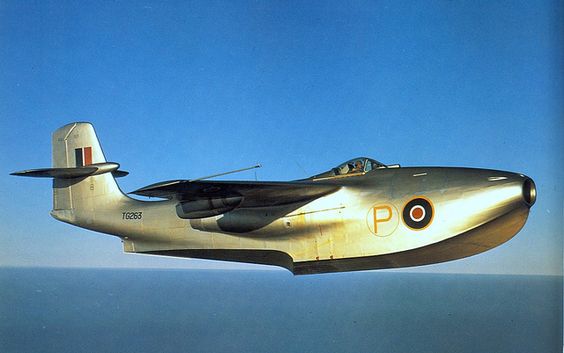
This aircraft was intended for service in the Far East, to be operated against the Japanese from rivers and lagoons in Burma and Malaya. In 1944, a manufacturer of patrol seaplanes received a contract for three prototypes of their tender to the E.6/44 specification, the extraordinary SR.A/1. The year before, as the Western Allies began to contemplate offensive operations in the Pacific, they came face to face with a problem that had bothered the Japanese a few years earlier.
Airfields were few and far between in the Pacific, and carriers were always in relatively short supply. Usable airstrips would generally be in Japanese hands and would be defended resolutely. Conventional land-based airpower could thus be had only at a high cost in lives and materiel. Like the Japanese, the British thought that a seaplane fighter might be very useful under these conditions.
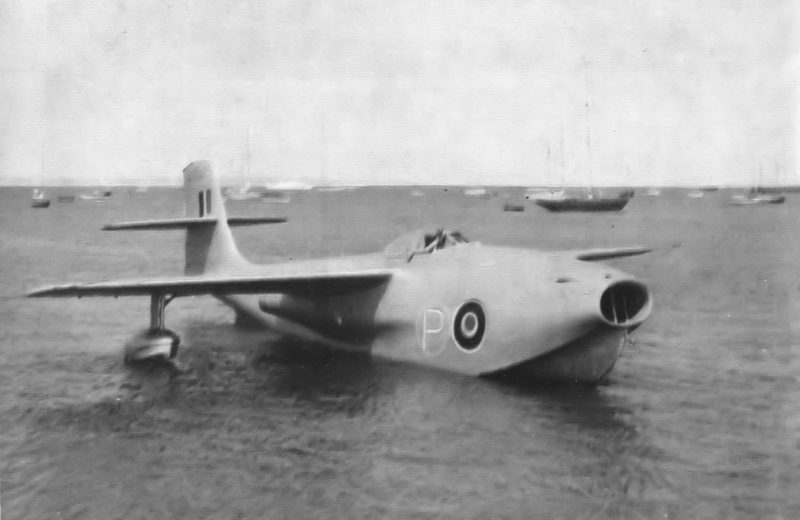
A latter-day Rufe or Rex could turn any moderately sheltered anchorage into a forward air base. Such fighters had always suffered a performance penalty vis-à-vis land-based warplanes, of course. The weight and drag of the flotation system made this inevitable. But, by 1943, turbojets were available. With no propellers to worry about, the designer could adopt a shallow, low-drag flying boat hull rather than the ungainly pontoons and struts of a conventional fighter seaplane. Takeoff runs from a watery runway could be as long as they had to be, so range and all around performance might well equal or exceed the best figures for land- or carrier-based aircraft.
Chief Naval Test Pilot Lt Cmdr Eric “Winkle” Brown flew the third SR A/1, TG271, for the first and only time on 12 Aug 1949 at the behest of Saunders-Roe. He wrung out the tubby little ‘boat, reaching Mach .82, pretty much the top speed of the SR A/1, in a dive. On landing, a submerged log holed the front hull and ripped off the starboard stabilizing float. Despite his best efforts, Brown could not keep the starboard wing from digging in and cartwheeling TG271 onto its back. Struggling free underwater, Brown almost succumbed, but was held up by Geoffrey Tyson, the Saro test pilot responsible for the majority of the SR A/1 testing, who had leapt off the supporting launch when he saw Brown in trouble. Despite extensive searching, the sunken third SR A/1 prototype was never located. Bill Devins
The SR./A.1 was directly inspired by the (modest) successes experienced by the Imperial Japanese Navy with seaplane fighters such as the Nakajima A6M2-N (an adaptation of the Mitsubishi Zero) and the Kawanishi N1K. In theory, seaplanes were ideally suited to conditions in the Pacific theatre, and could turn any relatively calm area of coast into an airbase. Their main disadvantage came from the way in which the bulk of their floatation gear penalised their performance compared to other fighters.
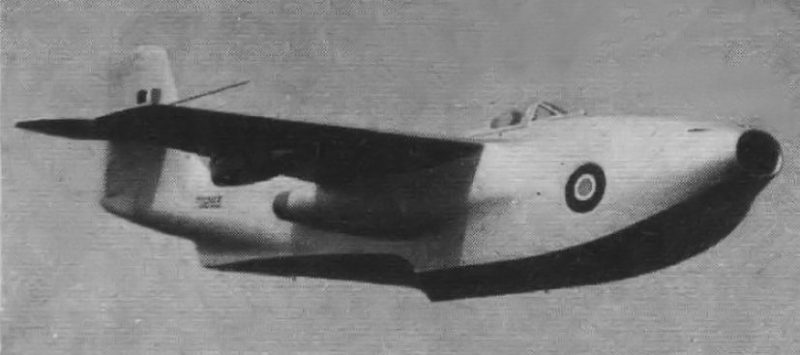
Saunders-Roe realised that the new turbojet engine presented an opportunity to overcome this drawback. Not requiring clearance for a propeller, the fuselage could sit lower in the water and utilise a flying boat-type hull. The company first presented their idea – SR.44 -to the Air Ministry in mid-1943. Performance with Halford H.1 engines was estimated at 520 mph at 40,000 ft. Criticism of the design included the wing thickness/chord ratio which was considered by the Ministry to be too high for a high-speed fighter operating at altitude. The design was modified and specification E.6/44 was raised in April 1944 on the modified design with an accompanying development contract for three prototypes in May 1944.
With the end of the war and Saunders-Roe concentrating its efforts on their Saunders-Roe Princess very large long range civilian flying boat project, construction slipped behind.
The first prototype, piloted by Geoffrey Tyson, flew on 16 July 1947, and while it and its two sisters proved to have good performance and handling – Tyson made a demonstration of aerobatics and inverted flight at the 1948 SBAC Display -, the need for such aircraft had completely evaporated with the end of the war. Furthermore, the success of the aircraft carrier in the Pacific had demonstrated a far more effective way to project airpower over the oceans though Saunders-Roe argued that carriers and their escorts were still very vulnerable to aircraft or other vessels.
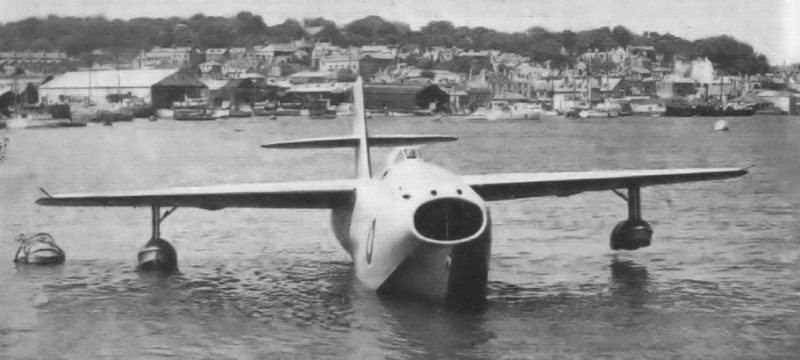
In addition, the cockpit canopy was small and heavily framed, giving the pilot a poor view outside the aircraft. An automatic mooring system was incorporated so the pilot could moor the aircraft without external aid or leaving the cockpit. A fundamental problem was that production of the Beryl engine had ceased when Metropolitan-Vickers had withdrawn from jet engine development, and only a limited number of engines were available. The project was suspended and the prototype put into store in 1950, but was briefly resurrected in November 1950 owing to the outbreak of the Korean War, before realisation of its obsolescence compared with land-based fighters and an inability to solve the engine problem forced a final cancellation, the prototype last flying in June 1951. Saunders-Roe came up with a design with skis which Flight called the “Saunders Roe Hydroski” to improve the performance closer to land-based aircraft but “received no official support”.
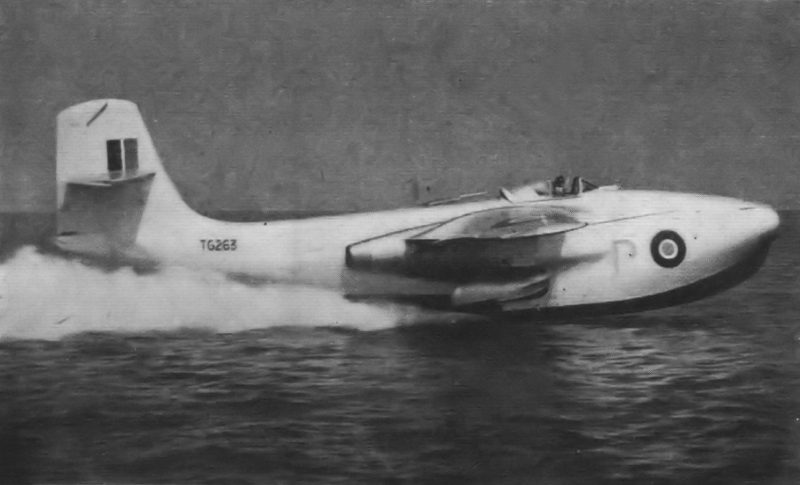
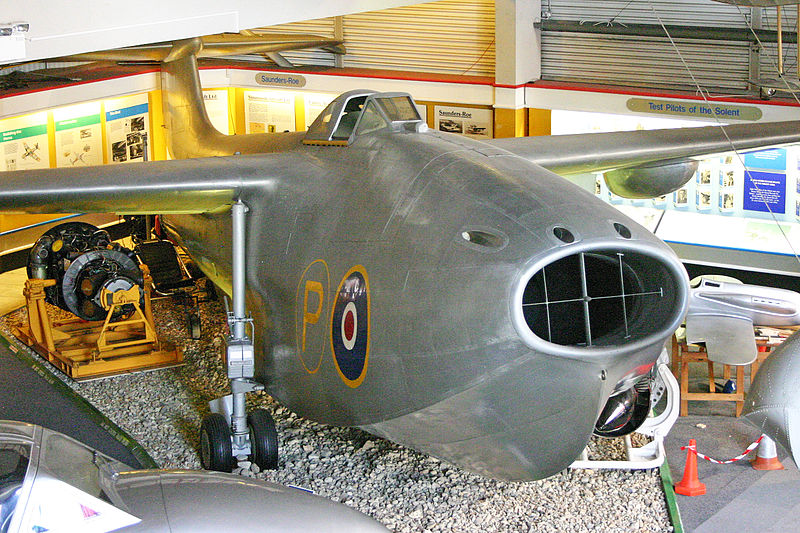
Although the aircraft never received an official name, it was referred to by company workers as ‘Squirt’. The two SR./A.1 prototypes were fitted with the first two production Martin-Baker ejection seats built.
Timeline
- 1943: Saro proposes SR.44 jet fighter seaplane for use in Pacific Theater.
- May 1944: Specification E.6/44 announced.
- July 1947: First prototype SR.A/1 TG263 rolled out.
- 16 July 1947: First flight of first prototype SR.A/1 TG263.
- 30 April 1948: First flight of second prototype, TG267.
- 17 August 1948: First flight of third prototype, TG271.
- 1949: TG267 crashed into the sea during air show rehearsal with loss of pilot Squadron Leader K. A. Major and aircraft.
- August 1949: Program cancelled; first prototype used by Saro for experimental research under civil “B-type” registration G-12-1; third prototype sank in the Solent after hitting a submerged object; pilot Captain Eric Brown survived; parts of aircraft recovered.
- June 1951: Last flying SR.A/1, TG263, retired to Cranfield Institute of Technology as an instructional airframe.
- 1966: TG263 purchased by Peter Thomas for his Skyfame Museum in Gloucestershire.
- 1978: TG263 to Imperial War Museum collection at Duxford.
- 1993: TG263 to Hall of Aviation Museum, Southampton.
